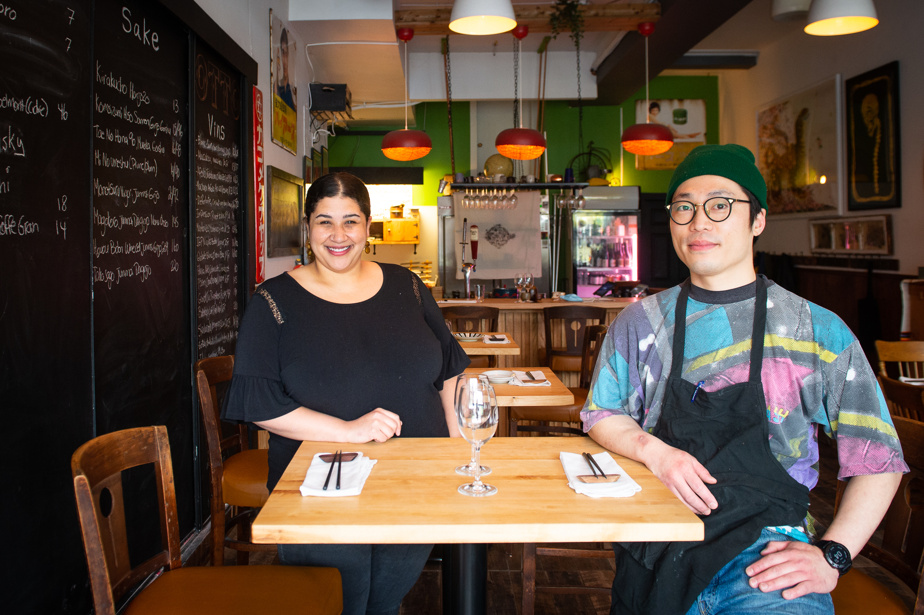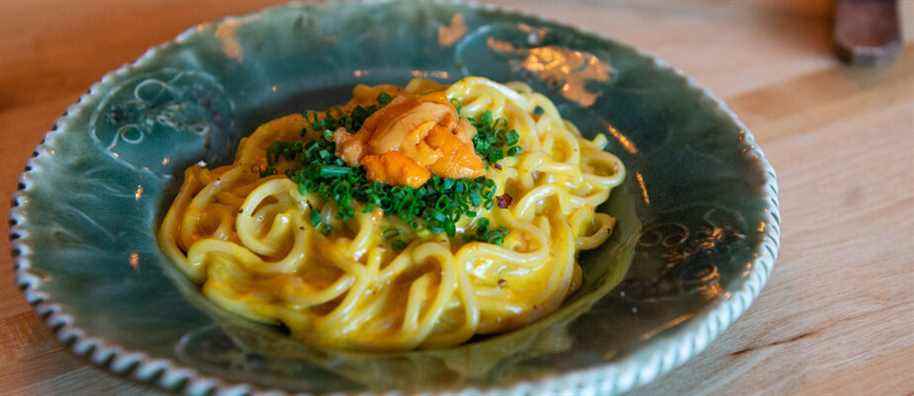Through the good shots and, sometimes, the not so good, our restaurant critics tell you about their experience, introduce the team in the dining room and in the kitchen, while explaining what motivated the choice of the restaurant. This week, we offer you an iconoclastic Japanese cuisine experience at Otto Bistro.
Posted at 11:00 a.m.
Why are we talking about it ?
There have been advances in Quebec in terms of Japanese cuisine. Formerly almost exclusively synonymous with sushi and teriyaki, the Japanese restaurant here was first enriched with dozens of ramen addresses, more or less formatted izakayas, then then small more specialized tables: yakitoris (skewers ), takoyakis (octopus fritters), omakase formulas (carte blanche in many services). Although I haven’t had the pleasure of traveling to Japan yet, Otto Bistro makes me feel like the kind of little tables that dot the more underground big cities, where the chef allows himself to express his unique and personal style.
Who are they ?

PHOTO CATHERINE LEFEBVRE, SPECIAL COLLABORATION
Dominique Brown and Hiroshi Kitano are often the only two restaurant workers and they like it that way!
In Montreal, that chef is Hiroshi Kitano. Born in Ise, a small town located in the center of the main island, he found himself becoming passionate about cooking through a small food job. The expatriate then trained in the small and large tables of New York, ending up in a restaurant with kappo cuisine, the most ceremonial there is. It was the famous Hirohisa, in SoHo. Not wishing to raise their family in the Big Apple, he and his partner chose Montreal, where Hiroshi participated in the creation of the small Otto group. Now separated from Otto Yakitori Izakaya and Bar Otto, the chef leads his boat on the Plateau, alone in the kitchens of his “bistro”. He wanted to devote himself fully to the kitchen and give up management. In the dining room, he can count from the start (four years ago) on Dominique Brown, hospitality incarnate! As soon as we set foot in the 16 to 18-seat room on Avenue du Mont-Royal Est, the smiling eyes and overflowing kindness of the waitress immediately make us understand that we can make ourselves at home and that the evening will be comfortable. Only one other employee helps out on duty. In times of labor shortage, a restaurant with two and a half workers is ideal!
Our experience
-

PHOTO CATHERINE LEFEBVRE, SPECIAL COLLABORATION
This very spicy and tasty tofu is not for vegetarians, since it contains lamb.
-

PHOTO CATHERINE LEFEBVRE, SPECIAL COLLABORATION
The maguro futomaki is a plump roll made with two distinct parts of the tuna, including the fat belly.
-

PHOTO CATHERINE LEFEBVRE, SPECIAL COLLABORATION
At Otto Bistro, Hiroshi Kitano rediscovered the pleasure of cooking.
-

PHOTO CATHERINE LEFEBVRE, SPECIAL COLLABORATION
The large paintings on the walls (like the skeleton) are by painter and tattoo artist Jonathan Bourassa. Other decorative elements were found in Japan by the chef’s brother. Eclecticism is the watchword.
-

PHOTO CATHERINE LEFEBVRE, SPECIAL COLLABORATION
In the summer, it’s not impossible for the “garage” door to be completely open and for reggae to escape.
1/5
Otto Bistro is both a neighborhood restaurant, where you can devour a bowl of mazemen (“dry” ramen, so without broth) with a beer and then return, and a destination to discover rare and high-end, in the most relaxed atmosphere possible.
The large paintings on the walls are by painter and tattoo artist Jonathan Bourassa. Other decorative elements were found in Japan by the chef’s brother. Eclecticism is the watchword. In summer, the “garage” door opens completely and it is not impossible that reggae escapes.
Like most of his colleagues, Hiroshi orders his fish and seafood from major supplier True World Foods. He makes the most of seasonal produce. During our visit, for example, the Hotaru Ika (small firefly squid) was on the menu, in a ramen dish with clams and their juice.
But after a decent little starter of very good fried chicken — the classic karaage — and Brussels sprouts bathed in a coating soy/balsamic sauce with tons of crunchy nuts, we opted instead for house classics.
First there is the “sea” avenue. The sashimi changes regularly. It is possible to order an assortment of 10 or 20 pieces or, like us, to eat them in chirashi, this pretty bowl of rice topped with various raw fish of the moment, egg, cucumber, a leaf spicy shiso, wasabi and nori.
Then there is the “terre” option, with, in particular, duck confit mazemen. By cracking the very lightly poached egg, you get a kind of carbonara that is really rich, salty, crispy thanks to the well-browned duck skin. In the same style, there is also the “uni carbonara” as a starter, with sea urchin.
The expression “fusion cuisine” being almost taboo in 2022 (but its reality is still very present!), Hiroshi dares not use it to talk about his cuisine. However, he is not shy about borrowing from Italian cuisine (mazemen burrata), Chinese (delicious and spicy mapo lamb tofu), Indian (curry keema), for example. You guessed it, the chef did not follow the “traditional” route, but rather the iconoclast. He had also told us, several years ago, that he could not imagine returning to the too restrictive Japanese society. It’s good for us!
In our glass

PHOTO CATHERINE LEFEBVRE, SPECIAL COLLABORATION
Dominique Brown always tries to keep a good selection of sakes.
It is Dominique Brown who takes care of ordering the liquids here. She always tries to keep a good selection of sakes, although the supply has been spotty lately. “I love when a customer tells me he or she doesn’t like sake. It becomes a personal challenge to find something he likes and I almost always succeed! “, tells us the one who started the more serious study of this rice alcohol. She also chooses wines from agencies working with vine artisans. There are several options by the glass, whether you are rice, grapes or both!
Good to know
There are few vegetarian dishes and even fewer vegan dishes on the menu, but the chef can adapt a few to make them “meat and fish free”, such as the mushroom mazemen.
Price
A bowl of ramen, whether in broth or not, will set you back $17 to $26. The addition becomes more salty when you “fall” into the fish, which is completely normal. Chirashi, for example, costs $38. Otto Bistro’s prices are very reasonable for the quality of the products. “By having very low personnel costs, since there are not many of us, it is possible to have accessible prices”, explains Hiroshi.
Information
Otto Bistro is open Wednesday to Sunday, 5 p.m. to 10 p.m., and Saturday and Sunday, noon to 1:30 p.m.
143 Mont-Royal Avenue East, Montreal

